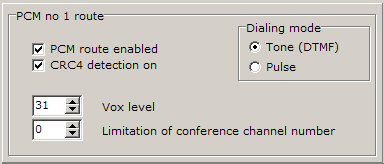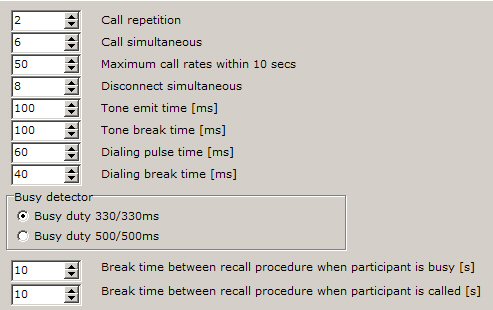The bookmark PCM routes makes it possible to set some options for the PCM routes single or for
both routes common. Single settings are as follows:
 |
- Route switch on/off. If the PCM route is switched off, it isn't scanned in firmware.
(even though the cable is plugged on). If the PCM route is switched on, it is scaned in firmware.
- CRC4 switch on/off. If this checkbox is checked, CRC4 is switched on in the KKO card.
- Channel limitation in the conference. This is maximum channel number for given konference.
Value 0 means no limits i.e. the conference is able to work on all available channels.
This is default value (no limitation). This feature may be usefull if we want to split
permanently all channels between two conferences. E.g. for the KKO30 if we set up limitations 15/15
it will be work with maximum 15 PCM channels in each conference.
- VOX detector level. This is firmly setted on optimal value. If you want increase
sensitivity of the vox device, you should write smaller value in this window.
- Dialling mode. You can set pulse ot tone (DTMF) dialling. You set there outgoing
dial mode from the KKO to external exchange. KKO receives both dialling modes always.
Common settings for PCM routes:
 |
- Redial repetition number. This is the number of recall cycles when a subscriber
is busy (the time is set in another parameter) or if subscriber doesn't take on the call
(usually 3 minutes delay time exists). Default value is 3, maximum 100 minimum 0.
If you set 0 value recall procedure will not happen.
- Call simoultanously. This is number of channels where the KKO card dials to the external
exchange. If parameter is small, traffic intensity will be limited. Default value is 6,
maximum 8 minimum 1. Notice! If you set "calling confirmation" option, maximum call
simoultanously is limited by number of DTMF receivers on KKO (it amounts always 4) independent on
the value set in this parameter.
- Maximum call rates within last 10 seconds. This parameter limits traffic generated
by KKO card to an exchange. MD110 exchange in multi-lim version, accepts 9-10 calls only within 10 seconds
time interval. If this rate is exceeded, special alarm 110 "High Call Rate" can be generated
and some calls may be rejected by an exchange. If the limitation is in use, the KKO card
controls number of calls in last 10s and limits number of calls in given time.
Default value is 50, maximum 50, minimum 1. For the MD110 exchange in multi-lim version, it is
required to set up this parameter on value maximum 10 (total time of callig will be decreased of course).
- Disconnection simoultanously. This is the number of channels where the KKO card disconects
to external exchange. If this parameter is small, traffic intensity will be limited.
Default value is 8, maximum 30 minimum 4.
- DTMF tone time. This is the emition time (in miliseconds) for DTMF tone signal from the KKO.
This parameter is valid for outgoing tone mode only. Default value is 100ms,
maximum 1000ms minimum 50.
- DTMF break time. This is the noise time (in miliseconds) for DTMF break signal from the KKO.
This parameter is valid for outgoing tone mode only. Default value is 100ms, maximum 1000ms,
minimum 50.
- Pulse make time. This is the make time (in miliseconds) for pulse from the KKO.
The KKO dials by change ABCD bits with CAS protocol. This parameter is valid for outgoing pulse
mode only. Default value is 60ms, maximum 200ms minimum 50ms.
- Pulse break time. This is the break time (in miliseconds) for pulse from the KKO.
The KKO dials by change ABCD bits with CAS protocol. This parameter is valid for outgoing
pulse mode only. Default value is 40ms, maximum 200ms minimum 30.
- Busy detector. You can set two standard values of busy detector on KKO card:
330/330ms or 500/500ms. Busy detector is based on vox hardware and it runs if subscriber is called
and he doesn't take on this calling. If busy tone is detected, subscriber's icon will change on the 'busy' status.
This informations makes it possible to call this subscriber by dispatcher again.
- Break time between recall procedure when busy. This is the break time (in seconds)
between two next subscriber's calling into the conference in case of the subscriber is busy.
So, total time of repetition (collecting conference participants time) is this "Break time"
multiplayed by "Redial repetition number". Default value is 10s, maximum 1 minute and minimum is 5s.
- Break time between recall procedure when no answer. This is the break time (in seconds)
between two next subscriber's calling into the conference in case of the subscriber is absent.
So, total time of repetition (collecting conference participants time) is this "Break time"
multiplayed by "Redial repetition number". Default value is 60s, maximum 60s and minimum is 10s.
 kClient HTML Help: SETTINGS-PCM ROUTES
kClient HTML Help: SETTINGS-PCM ROUTES kClient HTML Help: SETTINGS-PCM ROUTES
kClient HTML Help: SETTINGS-PCM ROUTES
